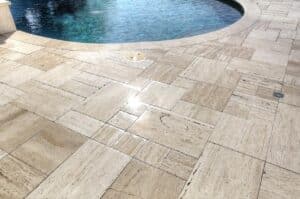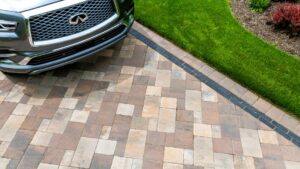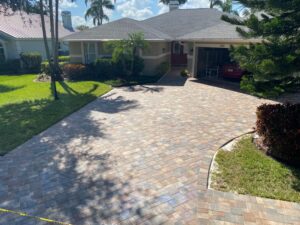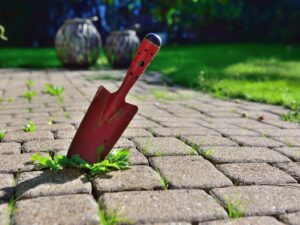Pavers are currently the most popular choice for hardscape projects, offering durability, versatility, and aesthetic appeal. However, one common issue that can affect many homeowners is paver discoloration. So why exactly does that happen – and how can you deal with it? This phenomenon, though frustrating, is not uncommon and can be caused by various factors.
The goal of this article is to explore all these points and discuss potential solutions to restore your outdoor space to its former vibrancy. If you’d like to read our complete guide on paver restoration instead, click here.
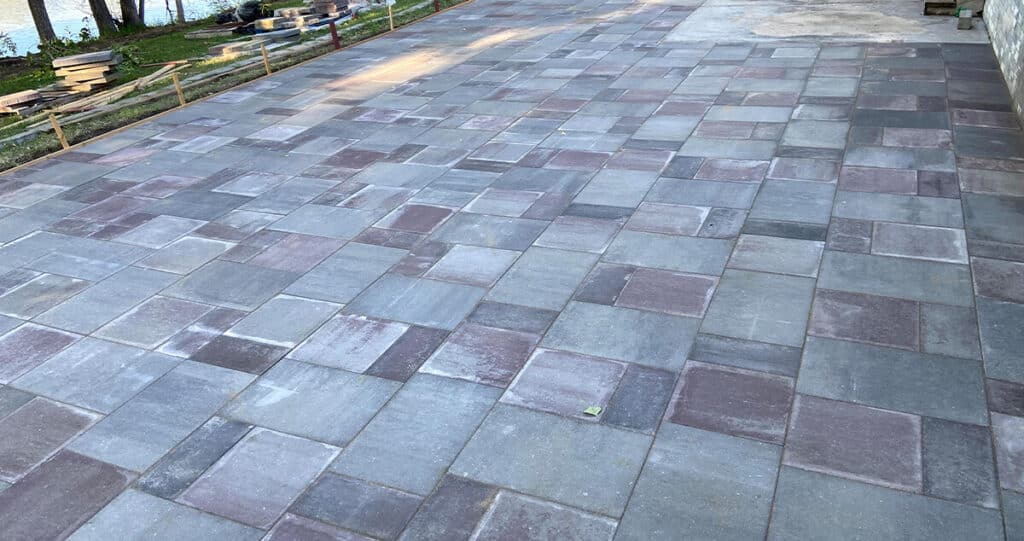
Paver discoloration: possible causes
Natural weathering
Pavers, being constantly exposed to the elements, undergo a gradual transformation due to natural weathering. The relentless impact of rain, sunlight, and atmospheric conditions can contribute to the fading and alteration of their original color.
UV rays from the sun, in particular, play a significant role in breaking down pigments within the pavers, resulting in a progressive loss of color vibrancy over time.
Mold and mildew growth
Pavers located in damp and shaded areas are prone to the development of mold and mildew. Besides posing potential health risks, these unwanted organisms can tarnish the surface of the pavers.
The combination of moisture and organic debris creates an ideal breeding environment for mold and mildew, leading to discoloration as well as compromising the aesthetic appeal of the paved area.
Efflorescence (in concrete pavers)
Concrete pavers often face the particular problem of efflorescence. This is a natural phenomenon that occurs when water-soluble salts migrate to the surface of the pavers, leaving behind a distinctive white, powdery residue.
Beyond affecting the color, efflorescence can also alter the texture of the pavers, creating an additional challenge in maintaining the original look of the paved surface.
Stains
Accidental spills of oil, grease, or other substances on pavers can result in stubborn stains – which not only disrupt the uniformity of color but also necessitate specific cleaning methods for effective removal. The presence of these stains can be visually displeasing and may require prompt attention to prevent long-term discoloration.
Inadequate sealing
If pavers are not adequately sealed during installation or if the sealant has worn off over time, they become more susceptible to discoloration.
Sealants act as a barrier, protecting the pavers from various environmental factors, so paying extra attention to that at the moment of the installation can make all the difference in the long run.
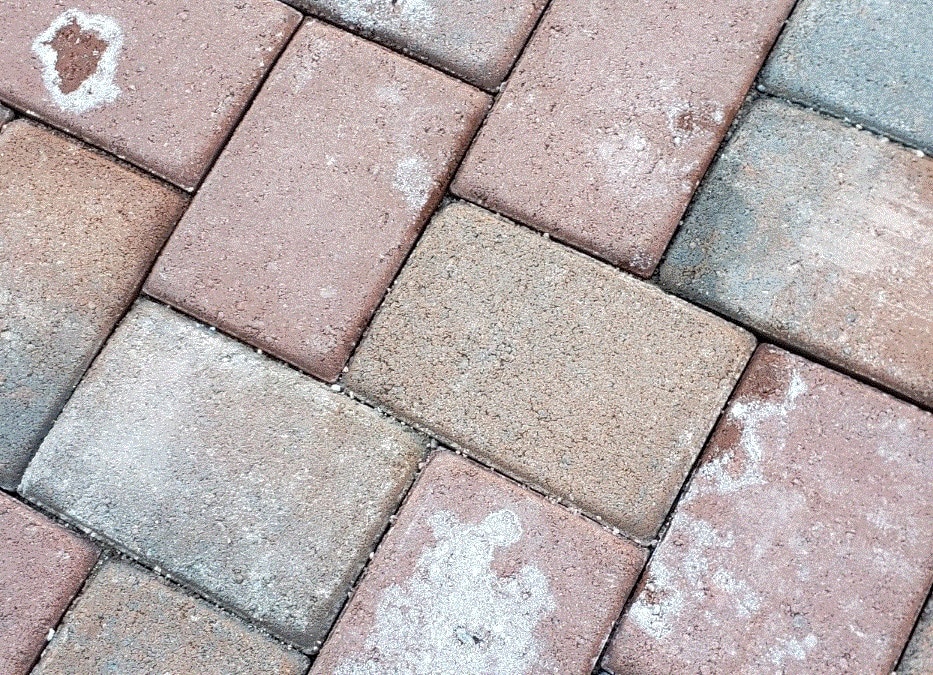
Addressing the problems
Regular cleaning is by far the best thing you can do to prevent paver discoloration.
Perform routine cleaning at least twice a year, or more frequently if the pavers are exposed to heavy foot traffic or harsh weather conditions.
Use a mild detergent with a pH-neutral formula to avoid damaging the pavers. A mixture of one part detergent to ten parts water is generally effective.
Scrub the surface with a stiff brush to remove ingrained dirt and prevent the growth of mold and mildew.
In the most extreme cases, pressure washing can also be a great ally against paver discoloration.
Use a pressure washer with an adjustable nozzle to control the water pressure. Start with a lower setting and gradually increase if needed, as excessive pressure can erode the surface or force water into porous pavers, causing damage.
Keep the nozzle at a distance to avoid direct impact on the pavers. Test a small, inconspicuous area first, and be cautious around joints and edges.
If you’re dealing with concrete pavers and have an efflorescence problem, there’s no need to worry. As we mentioned, it is a natural occurrence in concrete pavers.
Still, you can recur to some efflorescence cleaners to improve the aesthetics of your pavers.
Efflorescence is caused by salts rising to the surface, and efflorescence cleaners contain acids or specialized agents to dissolve these salts without harming the paver material.
Follow the product instructions carefully, wearing appropriate protective gear. Apply the cleaner using a brush or sprayer, and rinse thoroughly.
Repeat if necessary, but avoid overusing these cleaners to prevent potential damage.
If you still have stubborn stains even after all these cleaning steps, you’ll probably need to recur to specialized stain removals.
Identify the type of stain before choosing a remover. Different stains, such as oil, rust, or organic matter, may require specific products.
Apply the stain remover as directed on the product label. It often involves scrubbing the affected area, allowing the product to sit for a specified time, and then rinsing thoroughly.
For tougher stains, multiple applications may be necessary.
After all the proper cleaning is done, sealing is the next area you should really pay attention to.
Choose a sealer based on the type of pavers you have. There are penetrating sealers, which absorb into the paver for long-lasting protection and enhance natural colors, and film-forming sealers, which create a protective layer on the surface.
Follow the manufacturer’s guidelines for application, ensuring the pavers are clean and dry. Apply the sealer evenly using a roller or sprayer.
Consider resealing every 2-3 years, or as recommended by the product instructions.
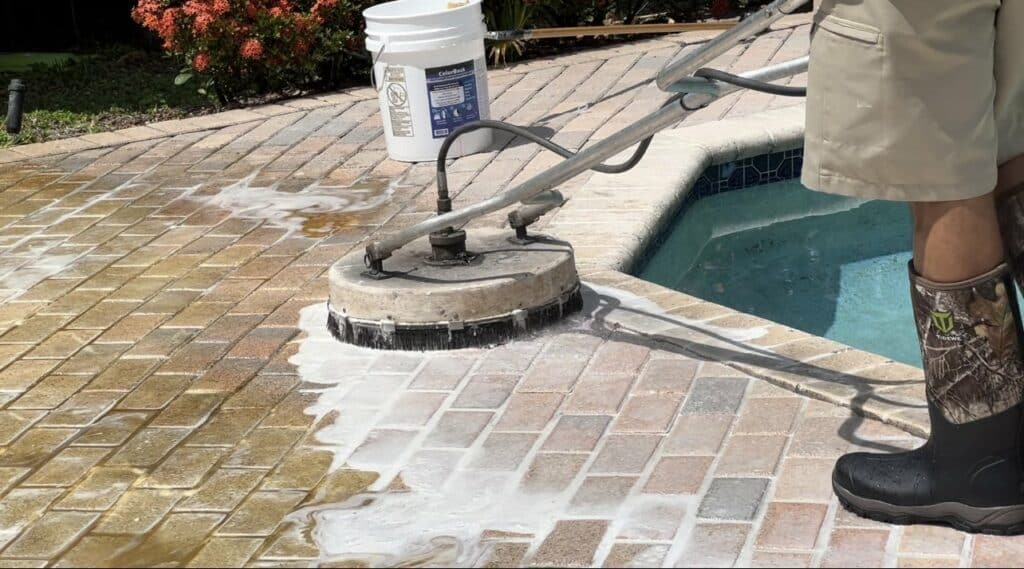
Professional cleaning and maintenance
As you can see, many factors might cause paver discoloration. Although many stains can be removed by cleaning, and prevented by properly sealing the pavers, sometimes pavers can be irremediably discolored and require full replacement.
Either way, your best course of action is to hire professional hardscape contractors to help you make a proper assessment of your situation and what would be the best course of action for you.
One thing is for sure: don’t try any homemade DIY cleaning options, especially those involving bleach or vinegar. They can permanently damage your pavers and become a bigger problem instead of a solution!
We here at S&S Pavers, during our 13 years of experience in hardscape, have seen many homeowners try DIY solutions only to worsen what could have been easily fixed by proper maintenance practices. So look for professionals you can trust around your area to help you – and in case you are around our area of activity, the Sarasota and Manatee counties, FL, why not get in touch with us to help you?
You can contact us anytime for a free estimate on our services, so we can start helping you with your paver discoloration, or any other hardscape needs you might have.

